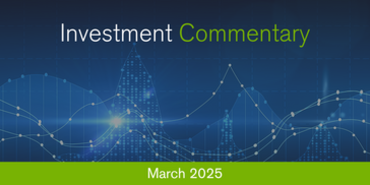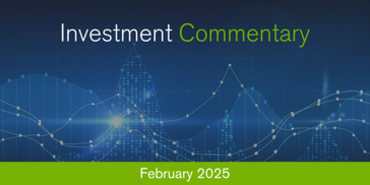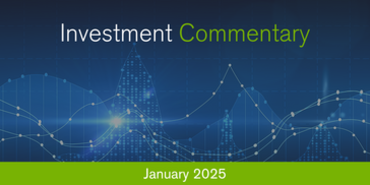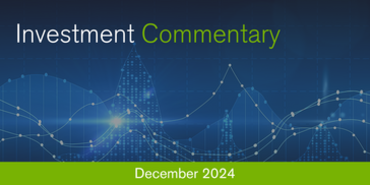Market Commentary Q2 2024

The resilient economic backdrop persisted into the second quarter, however, with data early on in the quarter was not perceived to be softening enough to provide much leeway for central banks to start cutting interest rates significantly. With investors pricing in fewer cuts once more, most sovereign bonds were down on the quarter following a weak April. Core CPI numbers in the US were also a cause for concern, with the March number the third consecutive month of core CPI at +0.4%. Geopolitical tensions in the Middle East were also heightened by a direct attack on Israel by Iran, leading to a rising oil price. However, tensions did ease towards the end of the period after further escalation did not occur.
As predicted, the European Central Bank did become the first of the major central banks to cut rates, delivering a 25bps cut at its June meeting. Other first movers included the Swiss Centra Bank, with its second cut in Q2 after a cut in Q1. The Bank of Canada also cut rates in June. This meant that four of the central banks with a G10 currency have now embarked upon rate cuts.
Another quarter, another strong period for risk assets, with several equity indices reaching all-time highs. Resilient economic data lent further support to the soft landing narrative and Q4 earnings were solid enough for equities to maintain their positive momentum. The picture was less rosy for bonds however, with central bankers tempering expectations of early rate cuts as well as there being a few upside surprises in the latest inflation readings.
Actual monetary policy changes were once again few and far between, however, the Bank of Japan’s remarkable monetary policy experiment came to an end in March, with the first interest rate hike in seventeen years. This also marked the first time in eight years that Japanese interest rates were in positive territory. At the other end of the scale, the Swiss National Bank became the first of the central banks with a G10 currency to cut rates in this cycle.
Against this largely positive backdrop, global equities posted strong returns, with the MSCI World Index up +9% during the period. Japanese equities continued their incredible run, with the Nikkei recording its best quarter since Q2 2009, with a return of +21.4%. The S&P 500 recorded back-to-back double-digit quarterly returns for the first time in over a decade, returning +10.6%, to reach a fresh all-time high. According to Deutsche Bank, the S&P was in positive territory for 16 of 18 weeks – the first occurrence since 1971. European equities were not far behind, with the Stoxx 600 returning +7.8%, also ending the quarter at a record high. UK equities lagged once more, with the FTSE 100 returning +4%. The laggards also included emerging markets, with the MSCI Emerging markets up +2.4%. Returns for this group were generally weighed down by underperformance from Chinese and Brazilian equities. Growth stocks continued to outperform value stocks, developed markets outperformed emerging markets and large cap stocks outperformed small caps.
As the prospect of aggressive rate cutting faded, bonds came under pressure once more. According to JP Morgan, the yield on the Bloomberg Global Aggregate Index increased by 28 basis points over the quarter, which led to negative returns of -2.1%. Sovereign bonds generally fared better than this but still recorded negative returns. US Treasuries, Eurozone sovereigns and UK Gilts returned -1%, 0.7% and -1.8% respectively. Eurozone sovereign bonds were helped by the performance of higher-yielding countries such as Italy, with its bonds returning +0.8% on aggregate. Credit outperformed during the quarter, with spreads narrowing slightly.
There were some fairly large moves in currencies during the period. The aforementioned Swiss interest rate cut took the markets somewhat by surprise, with the Swiss Franc one of the worst performers of the G10 currencies. It fell -6.7% against the US Dollar. The worst performer was actually the Japanese Yen, with a -6.8% versus the Dollar. With the interest rate increase well telegraphed, the Yen’s slide against the Dollar continued (after a rebound in Q4). It appears that market participants feel that the Yen carry-trade is still in play (borrowing cheaply in Yen to invest in a higher yielding currency such as the Dollar). In fact, the period was one of a strong Dollar generally as it strengthened against all the G10 currencies, with the Dollar Index returning +3.1%. Sterling was relatively robust over the quarter, falling modestly versus the Dollar and enjoying a positive return versus the Euro.
Commodities enjoyed steady returns over the period, with the CRB Index returning +5.1%. Oil prices continued their sharp rebound, with Brent and WTI returning +13.6% and +16.1% respectively. Gold continued its strong momentum with a return of +8.1%. This was in defiance of rising US real yields, which gold has an inverse relationship to historically. Industrial metals also had a solid quarter, with copper prices up +3%. The poorer performing commodities were soft commodities, with weakness for the likes of corn (-6.2%) and wheat (-10.8%). Natural gas priced continued to fall also.
Clients are advised that the value of all investments can go up as well as down. Any past performance or yields quoted should not be considered reliable indicators of future returns. Opinions, interpretations and conclusions expressed in this document represent our judgement as of this date and are subject to change. Furthermore, the content is not intended to be relied upon as a forecast, research or investment advice, and is not a recommendation, offer or a solicitation to buy or sell any securities or to adopt any investment strategy.
- Date
- 30/06/2024





